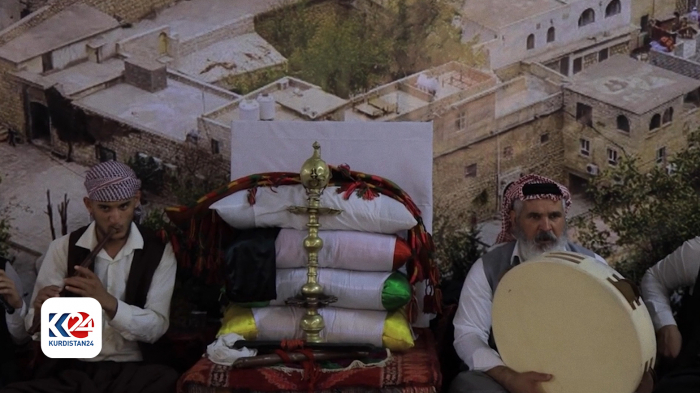Sacred Journey Tawus Tour: Reviving the Ancient Traditions of the Yazidis of Iraq

See below for photos from the ceremony
The annual Tawus Tour, known locally as "Gara Tawus," has once again embarked on its revered journey through the villages and communities of the Yezidis in Duhok province, culminating in the district of Ba’adre.
In Ba'adre subdistrict, part of the Sheikhan district, residents adorned in traditional white Yezidi clothing warmly welcomed the peacock symbol with pans, incense, tambourines, and religious music.
Khalid Narmo, an intellectual in the Ba'adre district, highlighted the significance of this event, noting that the "Gara Tawus" travels through all villages and communities in Duhok province and the Nineveh plain, with Ba’adre as its final stop.
He emphasized that this religious tradition, dating back over 1,000 years, has been pivotal in fostering social reconciliation within the Yezidi community.
According to Yezidi belief, God sent Angel Tawus to enrich the Earth with colors, making Tawus a holy emblem.
During the Ottoman Empire’s rule over Mosul, Yezidis possessed seven Tawuses. However, a genocidal campaign in 1892 led to the loss of several sacred objects, including Tawuses.
Today, only three of the original seven Tawuses remain, each embarking on distinct tours across various regions.
These include the “Tawus of Anzal,” the “Tawus of Sinjar,” and the “Tawus of Halab (Aleppo Tawus),” covering areas in Iraq and Syria.
Among these missing Tawuses, one was “Tawus of Masquf” and it used to be toured to Yezidi places in Georgia, Armenia and Russia.
The other one was the “Tawus of Zozana” toured in Hakare in Southern Turkey and north-most parts of the Kurdistan Region.
The other two Tawuses were the “Tawus of Khalta”, which toured inhabited places within Khalta tribe in Turkey, and the “Tawus of Tabreze”, which toured Yezidi areas in Tabriz, north west of Iran.
The ceremony involves communal meals, religious recitations, and social guidance, often resolving local issues.
The Qawals lead the procession, recite religious texts, and offer guidance. Faqirs provide blessings and serve Sherbik water, while ensuring that each family receives candles from the White Spring.
This ritual is followed by the religious dance, Govand, where participants receive blessings.
Sherbik is blessed water from the White Spring, served to people by Qawals.
Barat is sacred round object made of holy soil from Lalish, symbolizing Earth’s blessings.
Govand is a revered religious dance where people participate to receive blessings.
The Tawus Tour is a profound expression of Yezidi faith and culture, emphasizing the importance of unity, guidance, and social harmony.
As it travels through the Yezidi villages, it not only preserves ancient traditions but also strengthens the communal bonds that are the cornerstone of Yezidi society.
Tags: #yazidisinfo #newsyazidis #aboutyazidis #yazidisofiraq
Sacred Journey Tawus Tour: Reviving the Ancient Traditions of the Yazidis of Iraq

See below for photos from the ceremony
The annual Tawus Tour, known locally as "Gara Tawus," has once again embarked on its revered journey through the villages and communities of the Yezidis in Duhok province, culminating in the district of Ba’adre.
In Ba'adre subdistrict, part of the Sheikhan district, residents adorned in traditional white Yezidi clothing warmly welcomed the peacock symbol with pans, incense, tambourines, and religious music.
Khalid Narmo, an intellectual in the Ba'adre district, highlighted the significance of this event, noting that the "Gara Tawus" travels through all villages and communities in Duhok province and the Nineveh plain, with Ba’adre as its final stop.
He emphasized that this religious tradition, dating back over 1,000 years, has been pivotal in fostering social reconciliation within the Yezidi community.
According to Yezidi belief, God sent Angel Tawus to enrich the Earth with colors, making Tawus a holy emblem.
During the Ottoman Empire’s rule over Mosul, Yezidis possessed seven Tawuses. However, a genocidal campaign in 1892 led to the loss of several sacred objects, including Tawuses.
Today, only three of the original seven Tawuses remain, each embarking on distinct tours across various regions.
These include the “Tawus of Anzal,” the “Tawus of Sinjar,” and the “Tawus of Halab (Aleppo Tawus),” covering areas in Iraq and Syria.
Among these missing Tawuses, one was “Tawus of Masquf” and it used to be toured to Yezidi places in Georgia, Armenia and Russia.
The other one was the “Tawus of Zozana” toured in Hakare in Southern Turkey and north-most parts of the Kurdistan Region.
The other two Tawuses were the “Tawus of Khalta”, which toured inhabited places within Khalta tribe in Turkey, and the “Tawus of Tabreze”, which toured Yezidi areas in Tabriz, north west of Iran.
The ceremony involves communal meals, religious recitations, and social guidance, often resolving local issues.
The Qawals lead the procession, recite religious texts, and offer guidance. Faqirs provide blessings and serve Sherbik water, while ensuring that each family receives candles from the White Spring.
This ritual is followed by the religious dance, Govand, where participants receive blessings.
Sherbik is blessed water from the White Spring, served to people by Qawals.
Barat is sacred round object made of holy soil from Lalish, symbolizing Earth’s blessings.
Govand is a revered religious dance where people participate to receive blessings.
The Tawus Tour is a profound expression of Yezidi faith and culture, emphasizing the importance of unity, guidance, and social harmony.
As it travels through the Yezidi villages, it not only preserves ancient traditions but also strengthens the communal bonds that are the cornerstone of Yezidi society.
Tags: #yazidisinfo #newsyazidis #aboutyazidis #yazidisofiraq

































